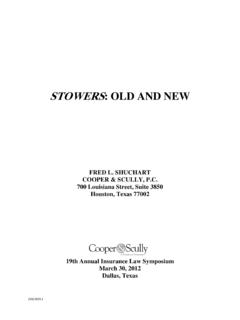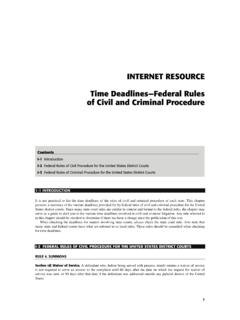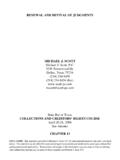Transcription of Contacting Employees of an Adverse Corporate Party: A ...
1 353 Contacting Employees ofan Adverse Corporate Party: A plaintiff s Attorney s ViewEllen J. Messing and James S. Weliky*The Model Rules of Professional Conduct, and their predecessorDisciplinary Rules, include prohibitions on direct ex parte contact be-tween lawyers and those represented by other lawyers in the text of Model Rules of Professional Conduct Rule reads:In representing a client, a lawyer shall not communicate about thesubject of the representation with a person the lawyer knows to berepresented by another lawyer in the matter, unless the lawyer hasthe consent of the other lawyer or is authorized to do so by law or acourt feature of these rules that has proven enormously controversial overthe years, and one with great practical impact on plaintiffs employ-ment lawyers, is the extent to which the rule prohibits ex parte contactbetween lawyers for individual employee plaintiffs.
2 On the one hand,and on the other hand, potential witnesses employed by corporationsor other organizations that are in a posture Adverse to those lawyers naturally seek the broadest possible access to suchwitnesses, while management-side lawyers ordinarily seek to limitaccess absent their express consent. Over the years, this issue hasspawned an extraordinary amount of litigation with widely disparateresults in various article analyzes the existing jurisprudence on point as itrelates to current employee -witnesses and former Employees in boththe private and public sectors, focusing only on civil is*Ms.
3 Messing and Mr. Weliky are partners in Messing, Rudavsky & Weliky, ,located in Boston, Massachusetts. The authors firm was involved in certain litigationdescribed in the article. The authors wish to thank attorney Lisa Bernt for her invaluableresearch assistance on this article. They also express their gratitude to Professors JohnLeubsdorf and Paul Tremblay for their insights and helpful editorial comments. A dif-ferent version of this article appeared as a chapter in REPRESENTINGPLAINTIFFS INTITLEVII ACTIONS(Aspen Publishers 2001). OFPROF LCONDUCTR.
4 (2004); OFPROF LCONDUCTDR The term or court order was added to the existing text of Rule by the Amer-ican Bar Association as part of a set of 2002 amendments to the Model Rules, In all other respects,the text of the Rule was This article does not address the question of whether Rule applies to com-munications made by or at the behest of government attorneys in the course of criminal35419 THELABORLAWYER353 (2004)written from the perspective of a lawyer for an employee seeking max-imum access to prospective witnesses. The law affecting each categoryof witness is summarized by grouping jurisdictions according to thegeneral category (permissive, restrictive, or intermediate) into whichthey fall.
5 The article then evaluates the various approaches and pro-poses an analytical framework for considering the issues raised bythis the outset, it should be noted that Rule precludes commu-nication with a witness the lawyerknowsto be represented. The ModelRules define knows as actual knowledge rather than reasonablyknows or should know. 4 Thus, a lawyer should not be faulted (or worse,sanctioned) for interviewing Employees not yet known to come withinthe ambit of the rule s prohibitions. The lawyer must, however, termi-nate the interview when the lawyer learns through inquiry or the wit-ness s statements that the employee falls into a prohibited The Ethical Constraints on Talking to CurrentEmployees of Corporate Opposing ViewThis view interprets ABA Model Rule of Professional Conduct , and its predecessor, DR 7-104(A)(1)
6 Of the Model Code of Profes-sional Responsibility, as prohibiting opposing counsel from communi-cating only with Employees in the corporation s control group ,the most senior Corporate managers without the Corporate attorney view holds that only the Employees with the power tocontrol the corporation may properly be equated with the corporation,investigations, a central and longstanding issue in discussions about the meaning andimpact of the DEP TOFJUSTICE,PROFESSIONALRESPON-SIBILITYAD VISORYOFFICE TOETHICS2000 COMMISSION(Mar. 13, 2001);see alsoRe-porter s Explanation of [2002] Changes to Model Rules,available ; MODELRULES OFPROF , cmt.
7 5 (2004).4. MODELRULES OFPROF LCONDUCTR. (f) Terminology (1995). Comm. on Ethics and Professional Responsibility, Formal Op. 95-396(1995) (no bar to communicating with represented person absent actual knowledge ofrepresentation); Gaylard v. Homemakers of Montgomery, Inc., 675 So. 2d 363, 367 ( ) (no sanction where no litigation had commenced and no reason to believe thatpotential defendant had retained counsel).Note that knowledge is even harder to infer under the 2002 version of the ModelRules. In February 2002, Comment [8] to Model Rule was amended to limit the cir-cumstances in which actual knowledge may be presumed.
8 The amendment deleted thesentence: Such an inference [of knowledge of representation] may arise in circumstanceswhere there is substantial reason to believe that the person with whom communicationis sought is represented in the matter to be discussed. MODELRULES OFPROF LCONDUCTR. cmt. 8 (2002),available R. PROF (a), (prohibits contacts with litigation controlgroup, defined as those with significant involvement in determination of corporation slegal position); Alabama Opinion RO 94-11 (Sept. 22, 1994),reprinted inNAT ANDPROF LRESPONSIBILITY(1995)
9 At 17 (lawyer representing client inboth a gender and age discrimination case, where client is named as a witness by defen- Contacting Employees of an Adverse Corporate Party355based on the theory that any Corporate action would not take placewithout their input, and thus only they are within the concept of a party 7for purposes of the no-contact avoid any risk of over-reaching, an attorney Contacting a witness who is outside of the controlgroup is generally required to (1) identify him/herself; (2) inform theemployee of the controversy at issue; and (3) inform the employee ofthe reason for the particular Views1.)
10 Model Rule Comment [4] TestUntil February 2002, when the ABA s House of Delegates approvedchanges to the Model Rule (discussed below), the official Comment [4]to ABA Model Rule of Professional Conduct Rule (1995) (in effectin many jurisdictions) stated:In the case of an organization, this Rule prohibits communications bya lawyer for another person or entity concerning the matter in repre-sentation with persons having a managerial responsibility on behalf ofthe organization, and with any other person whose act or omission inconnection with that matter may be imputed to the organization forpurposes of civil or criminal liability or whose statement may consti-tute an admission on the part of the corporation in age discrimination case.



